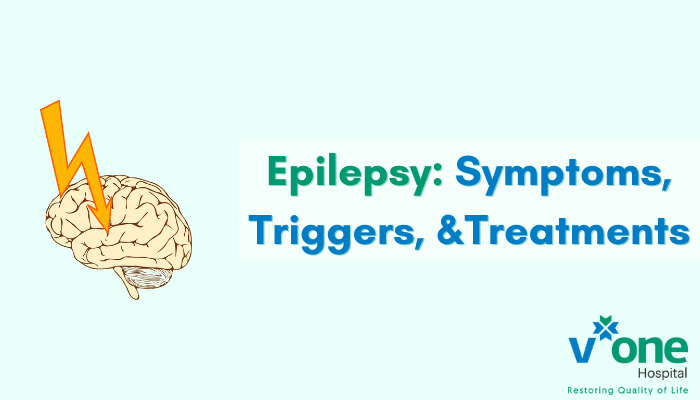Understanding Epilepsy: Symptoms, Triggers, and Treatments
Epilepsy is a condition that affects the brain and causes repeated seizures. It can affect people of all ages and often leads to fear, confusion, and stress, especially for those who are newly diagnosed. But the good news is, with the right medical guidance, treatment, and support, epilepsy can be effectively managed.
In this blog, we’ll walk you through what epilepsy is, its symptoms, common triggers, available treatments, and when to consult a neurologist.
What Is Epilepsy?
Epilepsy is a neurological disorder where brain activity becomes abnormal, leading to seizures. A seizure is a sudden surge of electrical activity in the brain that can affect how a person behaves, feels, or moves.
Not all seizures mean epilepsy. A diagnosis is usually made when someone has two or more unprovoked seizures that occur more than 24 hours apart.
Common Symptoms of Epilepsy
The symptoms of epilepsy can vary depending on the type of seizure and which part of the brain is affected. Some seizures are mild, while others may be more noticeable.
Here are some common signs to look out for:
- Sudden jerking movements of arms and legs
- Brief staring spells
- Loss of awareness or consciousness
- Confused behavior after a seizure
- Uncontrolled movements, especially during sleep
- Tingling sensations or changes in vision before a seizure
Sometimes, a person may experience a strange feeling, smell, or taste just before a seizure begins. This is called an “aura” and can act as a warning sign.
What Triggers an Epileptic Seizure?
Understanding what triggers seizures can help manage epilepsy better. Triggers are different for everyone, but some common ones include:
- Lack of sleep
- Stress or emotional upset
- Flashing lights or patterns (photosensitive epilepsy)
- Skipping meals or low blood sugar
- Fever or illness
- Alcohol or drug use
- Certain medications
- Hormonal changes (especially in women)
Keeping a seizure diary can be helpful. It allows patients and doctors to identify patterns and avoid specific triggers.
Types of Seizures
Epileptic seizures are mainly divided into two types:
1. Focal (Partial) Seizures
These begin in one specific area of the brain. Symptoms can be subtle, like changes in taste, smell, or sensation, or more obvious, like jerking in one part of the body.
2. Generalized Seizures
These affect both sides of the brain and may cause:
- Loss of consciousness
- Muscle stiffness or jerking
- Staring spells
- Sudden falls or body stiffness
Understanding the type of seizure is crucial for effective treatment.
How Is Epilepsy Diagnosed?
Diagnosis starts with a detailed history. A neurologist will ask about the episodes, symptoms, triggers, and family history. Some common tests include:
- EEG (Electroencephalogram): Records electrical activity in the brain.
- MRI or CT Scan: Helps identify structural issues in the brain.
- Blood Tests: To check for infections or metabolic problems.
Sometimes, you may need to stay in a hospital setting for continuous monitoring to get a clear diagnosis.
Treatment Options for Epilepsy
The goal of treatment is to control seizures with minimal side effects. Most people with epilepsy live full and active lives with the right treatment plan.
1. Medications
Anti-epileptic drugs (AEDs) are the first line of treatment. These medications help control electrical activity in the brain.
- It may take some time to find the right medication and dosage.
- Never stop or change medication without consulting your doctor.
2. Lifestyle Changes
Simple changes in your daily habits can help reduce seizure frequency:
- Get enough sleep
- Eat a healthy and regular diet
- Avoid alcohol and stress
- Stick to a consistent routine
3. Surgical Options
In cases where medications don’t work, surgery may be an option. The goal is to remove the part of the brain where seizures begin, if safe to do so.
4. Other Therapies
- Vagus Nerve Stimulation (VNS): A device implanted in the chest sends signals to the brain to help control seizures.
- Ketogenic Diet: A special high-fat, low-carb diet often used in children with hard-to-treat epilepsy.
Living with Epilepsy: Tips for Daily Life
Managing epilepsy is not just about medications—it’s about creating a safe and supportive environment:
- Inform close family and friends about your condition.
- Wear a medical alert bracelet.
- Avoid risky activities like swimming alone or climbing heights.
- Don’t drive until your seizures are under control.
When to See a Neurologist?
If you or a loved one has experienced a seizure or any unexplained blackouts, it’s important to consult a specialist.
For expert care and personalized treatment, consider consulting Dr. Partisha Narayan Bhargava, known as one of the best neurologists in Indore. Dr. Bhargava has vast experience in treating epilepsy and other neurological conditions with a compassionate, patient-first approach.
Early diagnosis and the right guidance can make a huge difference in managing epilepsy successfully.
Conclusion
Epilepsy may feel overwhelming at first, but with awareness, proper treatment, and support, it is a manageable condition. By understanding its symptoms, knowing your triggers, and working closely with a trusted neurologist, you can take control of your health.

